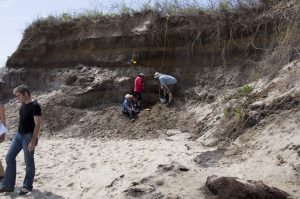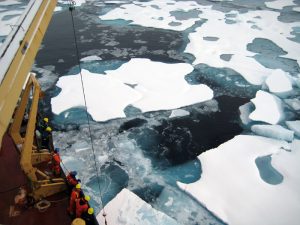Latest News
An atomic odyssey from the Great Calcite Belt to a data point by Sarah Rosengard and WHOI/MIT Joint Program student.

Dear friend of NOSAMS
We are sending this email to bring you up to date on activities and developments here at NOSAMS and to send you a copy of our new brochure. We are reaching out to you, as a member of our user community, to let you know what new services we have to offer, as well as to invite feedback on how we can do things better. Our website (https://www.whoi.edu/nosams) has recently been updated and improved to make it more useful to you and others. Please let us know if there is anything you’d like to see there. Our attached brochure is a one-page tri-fold document describing our services. If you would like copies to hand out to colleagues and visitors at your lab, please contact us and we will send some along. Also note that we will be exhibiting at the 2015 AGU Fall Meeting in December. Please visit us at the NOSAMS booth (#1315).
Our biggest news item is that, after nearly 10 years as director at NOSAMS, Dr. Bill Jenkins has retired. His steady leadership will be missed! We’re delighted to let you know that his replacement, Dr. Mark Kurz will be starting as director in September. Until then, Dr. Karl von Reden will be acting as director. Mark is an esteemed isotope geochemist who will bring fresh insight and leadership to the organization.
We are just beginning to review proposals for two internships that will be awarded again this year to U.S. based graduate students for research at NOSAMS. Our interns’ research involves application of radiocarbon measurements to an important oceanographic research problem and/or development of new techniques for radiocarbon measurement during 2 to 6 weeks of residency at NOSAMS. Candidates should submit a two-page proposal outlining the proposed work and motivation. Details are provided at https://www.whoi.edu/nosams/internships.
NOSAMS now offers rapid, high-throughput, low-cost analysis of 14C in carbonate samples (e.g., corals, carbonaceous sediments, speleothems, etc.). Using an automated gas-bench type interface on NOSAMS’ gas ion source, the method bypasses traditional graphitization and pretreatment steps. For U.S. federally-funded research the current cost is $57 per unknown with a minimum batch submission of 25 samples. Typical analytical precision is between 1.5 and 2%. Additionally, simple mixing measurements have shown that extensive cleaning of carbonate samples to remove organic material is not necessary with this method.
We are offering a similar reduced cost, lower precision analysis of organic carbon using our elemental analyzer and a closed-tube graphite preparation. We offer this service to users who are able to process their own samples in our laboratory. In the next few months, we will provide a similar service using the gas ion source.
NOSAMS has designed and developed a system to efficiently extract dissolved inorganic carbon (DIC) from seawater and groundwater samples for radiocarbon dating. The Rapid Extraction of Dissolved Inorganic Carbon System (REDICS) uses a gas-permeable polymer membrane contractor to extract the DIC from an acidified water sample in the form of carbon dioxide (CO2) and store it for stable and radiocarbon isotope analysis. The REDICS system offers multiple advantages to the DIC extraction method which has been used for over twenty years at NOSAMS, including faster DIC extraction, streamlined analysis, and minimized set-up and prep time. The system has been fully tested and is currently being scaled up and automated.
Our facility was at the forefront of establishing a new thermal analysis technique, Ramped PyrOx, as a valuable tool in the study of organic matter and its age in the environment. In this technique, a sample containing organic matter is pryolized or oxidized at a constant rate and the CO2 evolved is collected at discrete intervals for radiocarbon analysis. The initial application of the technique was to improve sediment chronologies in the Antarctic, but its utility at separating complex organic mixtures into fractions with different thermal stability is expanding its application to studies of soil dynamics, river-ocean carbon cycling and the fate of fossil carbon in atmospheric particulate matter.
We hope that you find this update useful and would appreciate any comments or feedback you may have.
Thank you and all the best,
The NOSAMS Facility Staff

Radiocarbon Dating
Archeologists use a number of methods to date the objects they find. Inscriptions etched in stone, pottery markings, and historical documents can all offer clues to an artifact’s age. But what happens when there’s no written information available and the design of an object can’t peg it to a particular time? If the artifact is organic—like wood or bone—researchers can turn to a method called radiocarbon dating. It’s a process that dates an object by analyzing the different forms of carbon it contains. In this interactive, learn how radiocarbon dating works, what it takes to determine a date in the lab, and why it’s challenging to pinpoint a date precisely.—David Levin
 NOSAMS’ clients Jeff Donnelly and Andrea Hawkes of prehistoric hurricanes shows the intensity and frequency of hurricanes the U.S. could experience could intensify as ocean temperatures increase with climate change. Read More…
NOSAMS’ clients Jeff Donnelly and Andrea Hawkes of prehistoric hurricanes shows the intensity and frequency of hurricanes the U.S. could experience could intensify as ocean temperatures increase with climate change. Read More…
 This article from phys.org highlights MIT/WHOI joint program student Li Ling Hamady student uses radiocarbon dating in to show Great White sharks grow much slower and live significantly longer than previously thought.
This article from phys.org highlights MIT/WHOI joint program student Li Ling Hamady student uses radiocarbon dating in to show Great White sharks grow much slower and live significantly longer than previously thought.
 A joint product of Woods Hole Sea Grant and Cape Cod Cooperative Extension, “What is that sticking out of the sand?” by Christopher Maio and Greg Berman describes “new” discoveries exposed thanks to coastal storms and erosion. Members of NOSAMS were able to be a part of this project.
A joint product of Woods Hole Sea Grant and Cape Cod Cooperative Extension, “What is that sticking out of the sand?” by Christopher Maio and Greg Berman describes “new” discoveries exposed thanks to coastal storms and erosion. Members of NOSAMS were able to be a part of this project.
 Check out this great article from Astrobiology Magazine featuring David Griffith (with support from NOSAMS) conducts a study to measure carbon at various depths in the Arctic Ocean.
Check out this great article from Astrobiology Magazine featuring David Griffith (with support from NOSAMS) conducts a study to measure carbon at various depths in the Arctic Ocean.
